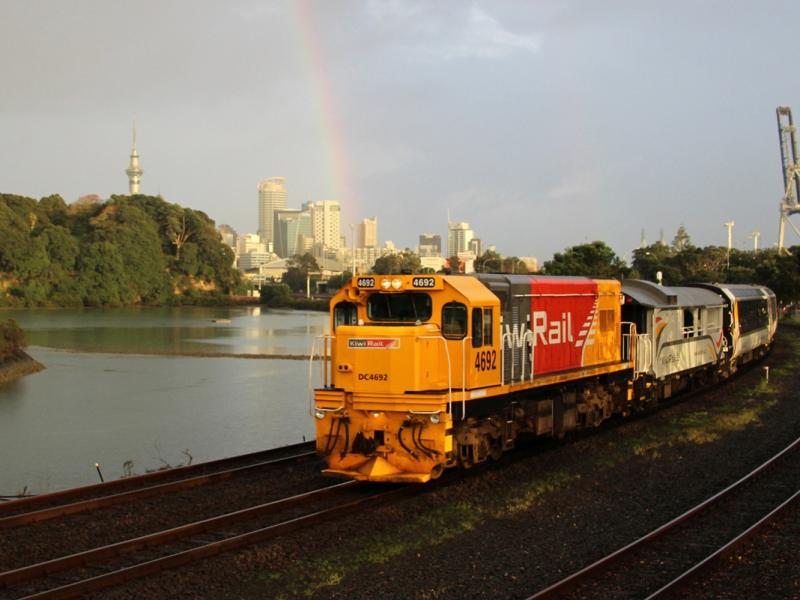Crown financial statements detail whopping $5.3 billion increase in the value of the national rail freight network to $6.3 billion with valuation done on a public benefit basis rather than a commercial basis

A change in the way the national rail network is valued means the Government has increased its carrying value by a whopping $5.3 billion to $6.3 billion.
This is disclosed in the Crown’s June year financial statements released on Tuesday.
“Following a review to consider the context of KiwiRail’s purpose within a multi modal transport system, the underlying assumption of the benefits of rail were reframed as: ‘Rail enables access and mobility, transporting people and goods to where they need to go, supporting productivity and business growth, reducing emissions, congestion and road deaths, and strengthening social and cultural connections between communities’. As a consequence, a valuation for the rail freight network that only reflected its cash generating potential was no longer appropriate,” Treasury says.
“These financial statements include the valuation of all the rail infrastructure using an Optimised Depreciated Replacement Cost [ODRC] method. To the extent that the assets deliver public benefits and would be replaced, a replacement cost approach is used, depreciated to reflect the extent the assets are through their useful lives. The valuation is ‘optimised’ by reporting components within the network that do not produce benefits, as surplus assets that are measured at their recoverable amount.”
“The impact is to increase the value of the rail freight network to $6.3 billion compared to a value of $1.0 billion that would have been reported under the previous basis,” says Treasury.
The Crown accounts also show a reversal of KiwiRail’s previous impairment expense of $2.6 billion, resulting from the change in the valuation approach of the rail network from a commercial basis to a public benefit basis.
Treasury notes the rail network comprises around 3,700 kilometres of track, excluding yards and sidings, and is used primarily for freight transport. It is, however, also used by KiwiRail for long distance passenger transport and access is provided to the Greater Wellington Regional Council and Auckland Transport regional authorities for metro passenger services. The rail infrastructure earns revenue from freight and long distance passenger charges. Network access charges are also collected from the two regional authorities for the metro services.
“Since the restructuring of KiwiRail as a profit-oriented entity in 2012, the rail network infrastructure used for freight services, including dual use assets required for freight operations, has been valued at fair value, reflecting the recoverable amount that could be expected to be received from a third party in an orderly transaction. The portion of dual use assets not required for freight operations and metro only assets were reported in these financial statements at an optimised depreciated replacement cost basis, reflecting the community benefits of this investment rather than treating this portion as a cash generating asset at a whole-of-Government level. Those valuation approaches reflected the government purpose in holding the assets,” Treasury says.
KiwiRail ‘remains a profit-oriented entity’
Treasury notes last year’s financial statements disclosed that the Government had initiated a rail review. This recognised the challenges in making investment decisions, marrying the duality of commercial “for profit” activities aligning a State Owned Enterprise’s commercial mandate with other “public benefit” activities that deliver social benefits instead of commercial returns, and integrating short-term funding commitments with investment decisions for long-life assets.
“The findings of the Review of Rail were reported to Ministers in May 2019, who noted that all rail, including freight, contributes to national and regional economic growth and reduces emissions and congestion, reduces road deaths and injuries, facilitates wider social benefits, and provides resilience and connection between communities. The report also noted the necessity of continued commercial disciplines and focus of KiwiRail to support efficiency in asset management, and to drive commercial returns from the provision of freight, property and tourism operations,” Treasury says.
Cabinet agreed in principle “to a resilient and reliable rail system to deliver on the outcomes for transport and wider benefits the Government seeks.” Budget decisions were made on this basis.
“As a consequence it is no longer appropriate at the whole-of-government level to reflect the rail freight network as a cash generating asset, ie, at its recoverable amount, given the wider reasons for the Crown’s investment in the rail infrastructure. This changed view at a whole-of-government level does not affect the treatment of the assets in the financial statements of KiwiRail itself, as it remains a profit-oriented entity.”

Thank you for your sharing. I am worried that I lack creative ideas. It is your article that makes me full of hope. Thank you. But, I have a question, can you help me? 创建个人账户